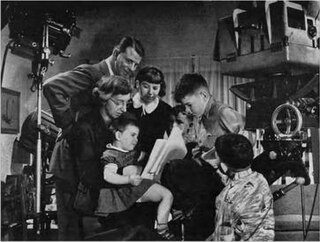Related Research Articles

William Norman McLaren, LL. D. was a Scottish Canadian animator, director and producer known for his work for the National Film Board of Canada (NFB). He was a pioneer in a number of areas of animation and filmmaking, including hand-drawn animation, drawn-on-film animation, visual music, abstract film, pixilation and graphical sound. McLaren was also an artist and printmaker, and explored his interest in dance in his films.

Cinema in Canada dates back to the earliest known display of film in Saint-Laurent, Quebec, in 1896. The film industry in Canada has been dominated by the United States, which has utilized Canada as a shooting location and to bypass British film quota laws, throughout its history. Canadian filmmakers, English and French, have been active in the development of cinema in the United States.

Frank Radford "Budge" Crawley, was a Canadian film producer, cinematographer and director. Along with his wife Judith Crawley, he co-founded the production company Crawley Films in 1939.

Nobody Waved Good-bye is a 1964 National Film Board of Canada production directed by Don Owen, starring Peter Kastner, Julie Biggs and Claude Rae. A sequel, Unfinished Business, was released in 1984.
Colin Archibald Low was a Canadian animation and documentary filmmaker with the National Film Board of Canada (NFB). He was known as a pioneer, one of Canada's most important filmmakers, and was regularly referred to as "the gentleman genius". His numerous honors include five BAFTA awards, eight Cannes Film Festival awards, and six Academy Award nominations.
Pas de deux is a 1968 short dance film by Norman McLaren, produced by the National Film Board of Canada.

Yorkton Film Festival (YFF) is an annual film festival held in late May in Yorkton, Saskatchewan, Canada.

Walking is a 1968 Canadian animated short film directed and produced by Ryan Larkin for the National Film Board of Canada, composed of animated vignettes of how different people walk.
The Street is a 1976 animated short film by Caroline Leaf for the National Film Board of Canada.

Blake is a 1969 Canadian short documentary film produced by the National Film Board of Canada (NFB). The film was directed by Bill Mason, and his fellow filmmaker Blake James, who pilots his own aircraft and lives by a unique code. Blake is Mason's cinematic testimonial to his friend and his "hobo of the skies" lifestyle.

James Beveridge (1917–1993) was a Canadian filmmaker, author and educator. Beveridge was a pioneering filmmaker at the National Film Board of Canada (NFB) and became Head of Production at the NFB in the post-war years.
Evelyn Lambart was a Canadian animator and film director with the National Film Board of Canada, known for her independent work, and for her collaborations with Norman McLaren.
Grant Holland Crabtree was a Canadian cinematographer, director, and photographer who worked during the early years of the Canadian film industry, first for Crawley Films, then for the National Film Board and the National Research Council. His work includes the highly touted The Loon's Necklace, The Chairmaker and the Boys, Morning on the Lièvre, and Song of Seasons.

Thomas Cullen Daly was a Canadian film producer, film editor and film director, who was the head of Studio B at the National Film Board of Canada (NFB).

Judith Rosemary (Sparks) Crawley was a Canadian film producer, cinematographer, director, and screenwriter. She and her husband Frank Radford "Budge" Crawley co-founded the production company Crawley Films in 1939.

Alethea Arnaquq-Baril is an Inuk filmmaker, known for her work on Inuit life and culture. She is the owner of Unikkaat Studios, a production company in Iqaluit, which produces Inuktitut films. She was awarded the Canadian Meritorious Service Cross, in 2017 in recognition of her work as an activist and filmmaker. She currently works part-time at the Qanak Collective, a social project which supports Inuit empowerment initiatives.
The 4th Canadian Film Awards were presented on April 27, 1952 to honour achievements in Canadian film.
The 1st Canadian Film Awards were presented on April 27, 1949 to honour achievements in Canadian film.
Morten Parker was a Canadian director, producer and writer.
Don Mulholland (1910-1960) was a film producer and director with the National Film Board of Canada (NFB). He was the NFB's first Director of Production, and the founding producer of the series Eye Witness. He was the first director to blend fiction and documentary, and is credited with shaping the course of Canadian film in the 1950s.
References
- ↑ "Award-winning film maker was a pioneer in industry". The Globe and Mail , May 15, 1987.
- 1 2 3 4 5 "The Loon's Necklace". screenculture.org. CESIF. Retrieved 28 March 2023.
- ↑ Mishler, Craig (2013). The Blind Man and the Loon: The Story of a Tale. Lincoln: University of Nebraska Press. ISBN 9780803239821.
- ↑ "The new loon: The Legend of the Loon's Necklace". Ottawa Citizen , July 23, 2005.
- 1 2 "Treasures from 'Canada's King of Film': F.R. Crawley gave the country its first feature film Oscar and changed driver's ed films". Toronto Star , February 27, 2016.
- ↑ Melnyk 2004, p. 93.
- ↑ "The Loon's Necklace". onf-nfb.gc.ca. National Film Board of Canada. Retrieved 28 March 2023.
- ↑ "Loon's Necklace Wins Canadian Film Award". The Globe and Mail , March 30, 1949.
- ↑ "Creative Canada: A Biographical Dictionary of Twentieth-century Creative and Performing Artists", McPherson Library, University of Victoria, University of Toronto Press 1972